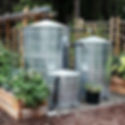7 Ways to build a more sustainable home
- Danielle Ursulan
- Sep 26, 2023
- 6 min read

Are you aware that Canada has plans to cap carbon emissions by 2024? This will lead to tighter regulations and increased taxes for Canadians based on carbon usage. As a result, building homes in the future will be significantly impacted, requiring us to make choices that reduce our carbon footprint and save money. Check out our tips for constructing an eco-friendly and budget-friendly sustainable home.
1. Use Certified Materials - One of the most essential components in selecting materials for your home is to ensure they meet the proper requirements for sustainability performance. It is necessary to use eco-friendly materials; using non-toxic, sustainable products helps safeguard your home and your health by minimizing the impact on the earth and your health. There are several green certifications that you should look for when selecting exteriors, flooring, paint, insulation, etc., but the top ones to look for are:

LEED GREEN - LEED (Leadership in Energy and Environmental Design) is the world's most widely used green building rating system. LEED certification provides a framework for healthy, highly efficient, and cost-saving green buildings offering environmental, social and governance benefits.

FSC CERTIFIED- This certification accredits forest managers, manufacturing companies, and controlled wood products that exhibit responsible consumption of forest products.

ENERGY STAR- The U.S. Environmental Protection Agency runs the Energy Star Program, one of the most recognizable eco-labels. This voluntary program rates products, such as appliances, electronics, and lighting fixtures, on energy efficiency. Energy Star also has a certification for new homes with superior heating and cooling efficiency and features Energy Star-certified appliances and fixtures.

WATER SENSE- The WaterSense label allows consumers to recognize products and programs that save water without sacrificing performance or quality. This label is issued by the U.S. Environmental Protection Agency (EPA) for products that are 20% more water-efficient than average products in the same category. The products must also perform better than their less efficient counterparts in categories such as toilets, faucets, urinals, and shower heads.

FORESTRY INITIATIVE- SFI chain-of-custody (COC) certification tracks the percentage of fibre from certified forests, certified sourcing and post-consumer recycled content. SFI on-product labels identify certified sourcing and COC claims to help consumers make responsible purchasing decisions.

GREENGUARD- GREENGUARD Certification ensures that a product has met some of the world’s most rigorous and comprehensive standards for low emissions of volatile organic compounds (VOCs) into indoor air. This certification has been widely adopted as a trusted standard for low-emitting products. More than 400 green building codes, standards, guidelines, procurement policies, and rating systems give credit to GREENGUARD Certified products.

FloorScore is the most recognized indoor air quality (IAQ) certification standard for hard surface flooring materials, adhesives, and underlayments. This certification was developed by the Resilient Floor Covering Institute (RFCI) in conjunction with Scientific Certification Systems (SCS) to test and certify hard surface flooring and flooring adhesive products for compliance with rigorous indoor air quality and low-VOC emissions requirements.

2. Install a Wood Stove- With the rising gas and carbon emissions cost, installing a wood stove is a great way to heat your home without gas or electricity. This alternative can drastically reduce your heating bill and add that cozy factor into your home during the winter months
A wood stove is a cost-effective and eco-friendly option for heating your home and can add a charming and rustic element to your interior design.
They also reduce carbon emissions and meet EPA standards, which helps our air stay cleaner, a bonus to installing one of these reliable heat sources.
Wood Stoves have been providing affordable alternative heating options for over 150 years. Simple yet powerful wood stoves have become increasingly popular due to their effectiveness and reliability during natural disasters. Imagine the peace of mind you would feel knowing that you have a dependable source of heat to keep your family safe and secure in any situation, and who doesn't love sitting next to a cozy fire in the cold of winter?
3. Upgrade your windows- Upgrading to Energy-Efficient Windows Can Save Money!
Did you know installing energy-efficient windows could save up to $583 annually?

Not only will this help reduce your bills, but it will also significantly decrease your energy consumption. Using an Energy Star window, you can reduce your energy consumption by 30%, helping preserve our natural resources and create a healthier, more sustainable planet for everyone.
But what makes a window energy efficient? Energy windows have multiple panes of glass, with an air space in the middle, which insulates much better than a single pane of glass, which keeps the heat in and the cold out, reducing your energy consumption.
4. Add a Solar Panel- Solar panels are a great way to add that sustainable element to your home. Solar energy uses the sun's light and heat to make renewable and green

Energy. This is important because Solar energy has much fewer carbon emissions than other energy that rely on fossil fuels.
Benefits of Solar Energy: Independence and Sustainability Solar energy has numerous benefits, but the most significant is it grants us energy independence. While fossil fuels are depleting at an alarming rate, the sun will continue to shine for billions of years. Installing solar panels gives your family the peace of mind that you will always have access to power, regardless of the available resources. Its Low Maintenance Most Solar panels come with an extended warranty of up to 25 years. In most instances, they only require annual cleaning, and the solar PV and thermal parts must be changed every ten years. They do not have moving parts, significantly decreasing the chance of something breaking or going wrong. They Benefit our electricity grid. Several provinces have implemented net metering policies to encourage solar power usage. These policies enable solar power generators to sell any excess electricity they produce to a utility at a retail rate and receive credit on their utility bill. The distinction is applied to the customer’s electricity consumption during other times of the day or year, which reduces the amount of electricity they need to obtain and pay for from a utility. This results in a reduced burden on the electric grid.

5. Collect Rainwater- Conserve, Conserve, and conserve is the key to Sustainable Living.
Conserving resources is vital to sustaining our planet; collecting rainwater is an excellent way to achieve this. It's free, easy, and can be used for watering plants, cleaning, bathing, or drinking. However, it's important to note that water maintenance is critical if you plan to consume it. Using rainwater has numerous environmental benefits, including reducing storm runoff that can prevent landslides, city flooding, and water volume flowing into streams, lakes, and rivers. This water conservation is increasingly important with the rise of natural disasters and wildfires. Limiting our water usage ensures that our firefighters can use the city's water to combat these disasters. Rain collection barrels can also help keep our lawns and gardens green while reducing water bills. The bulk of our water usage comes from watering our plants and properties, which rainwater can efficiently do, just like municipal water.
6. Install a waterless Toilet- Did you know that Switching to a Waterless Toilet Can Help Save Our Water Resources?

Surprisingly, 30% of our water consumption is wasted on flushing toilets. Consider replacing your traditional bathroom with a waterless one to reduce water usage and environmental impact. Different types of dry toilets exist, but composting and incinerating toilets are the most common. Composting toilets break down waste into nutrient soil while incinerating toilets burn up waste into bacteria-free ash. Both types have pros and cons, but composting toilets can be used without electricity and offer nutrient-dense compost for your garden. However, they require more maintenance as the waste is separated into separate tanks and must be emptied. Adding your organic compost to your garden for even healthier plants!
Incinerating toilets are a unique alternative for those looking for a low-maintenance option. After each use, these toilets burn up biological waste, transforming it into a scent and bacteria-free ash. While the ashtray requires emptying every 5-7 days, the maintenance is still less than composting toilets.
In areas where water and sewage systems are not available or difficult to install, incinerating toilets can be a great solution. They are also more flexible in home design, as they don't require traditional plumbing. However, it's essential to keep in mind that these toilets need a source of electricity to operate. Nevertheless, they are an environmentally friendly option that can significantly reduce water usage and support a more sustainable lifestyle.
7. Grow a Garden- A garden in your backyard has numerous benefits, including reducing air pollution and fossil fuel consumption by growing your food source instead of importing it. A garden can provide nutrient-dense food, which is better for your overall health while reducing your food bill significantly. Statistics indicate that every $1 spent on a seed generates $2.00 in produce, providing fresh food year-round for a fraction of the cost. By growing only what you need, you can limit food waste and

Reduce your environmental impact.
Growing your food also helps improve soil quality, which is essential to maintain the nutrients in the ground required for healthy crops. Harvesting and re-soiling yearly can erode the soil and decrease its nutritional value. By growing your food, you help avoid this issue. Moreover, increasing pesticide-free foods can positively impact our bee colonies, which are essential to our food resources. Most of our foods are genetically modified and sprayed, resulting in the loss of our bees and limited pollination. By growing our fruits and vegetables, we can ensure our bees have pollen and nectar-rich flowers to inhabit and thrive.
We can easily make our homes more sustainable by adopting simple practices. It's crucial to remain aware and deliberate about the choices we make every day. By doing so, we can ensure that our planet will continue to thrive for years.
